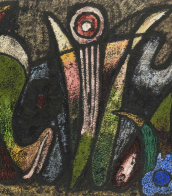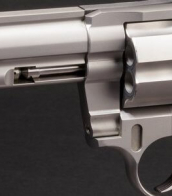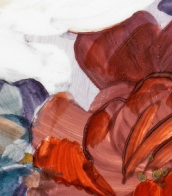treptow

Lyonel Charles Adrian Feininger was an American-German artist renowned for his unique integration of Expressionism, Cubism, and Bauhaus principles. His body of work, which spans several critical decades in modernism's development, is celebrated for its distinctive blend of architectural and nautical motifs, articulated through planar shifts and jagged lines of Cubism, with a vibrant Orphist color palette.
Lyonel Feininger's journey as an artist began in earnest when he was 36, becoming a pivotal figure in various German expressionist groups and a founding member of the Bauhaus, where he led the printmaking workshop. His art, which also includes significant contributions to caricature and photography, explores the intricate relationship between humanity and industrialization, evident in his depictions of architectural and mechanized forms.
His work was subject to Nazi criticism, being labeled as "degenerate," which led to his return to the United States, where he continued to evolve his artistic style. Posthumously, Lyonel Feininger's art has been the focus of several retrospectives, and his pieces, like "Jesuits III," continue to fetch high figures at auctions, underscoring his lasting impact on the art world.
Notably, Lyonel Feininger's "Cathedral" woodcut, representing the Bauhaus's utopian vision, remains one of his most iconic works, symbolizing the integration of art and craftsmanship with its avant-garde yet traditional approach. His legacy is further carried by his sons, Andreas and T. Lux Feininger, who also made their marks in the arts.
For collectors and art and antiques experts, Feininger's work represents a fascinating intersection of various art movements and a testament to the enduring nature of expressive and innovative artistry. To stay updated on new product sales and auction events related to Lyonel Feininger, consider signing up for updates, ensuring you're informed about the latest opportunities to engage with his enduring legacy.


Römer + Römer, consisting of Nina and Torsten Römer, is an acclaimed German-Russian artist duo known for their vibrant and immersive paintings. Born in different countries, with Nina hailing from Moscow, Russia, in 1978, and Torsten from Aachen, Germany, in 1968, they both met during their studies at the Kunstakademie Düsseldorf, where they became Master Students under A.R. Penck. Since 1998, they have collaborated as both a couple and a creative duo, making Berlin their home and workspace since 2000.
Their unique approach to art often involves engaging with contemporary culture and events, as seen in their diverse exhibitions. From capturing the essence of the Burning Man festival in "Burning Man – Electric Sky" to exploring social themes in "Generalstreik," their work spans a broad spectrum of subjects. Notably, their participation in the 56th Venice Biennale and exhibitions across various cities showcases their international recognition and appeal.
Römer + Römer's method of creation is deeply collaborative, emphasizing communication and joint creativity over individual genius. This dynamic has allowed them to navigate the complexities of working closely together, transforming potential conflicts into constructive discussions. Their work is characterized by a rich, pointillist technique that marries traditional painting with digital pixelation, creating a bridge between classical art forms and contemporary digital aesthetics.
For art collectors and experts, Römer + Römer's work offers a fresh perspective on landscape and portrait painting, infused with modern themes and innovative techniques. Their pieces are not only visually striking but also thought-provoking, inviting viewers to contemplate the intersections of art, technology, and society.
Stay informed about Römer + Römer's latest projects and exhibitions by subscribing to updates from art news platforms and galleries showcasing their work. This ensures access to the latest on sales, exhibitions, and new pieces by this dynamic duo, further enriching your collection and understanding of contemporary art.


Lyonel Charles Adrian Feininger was an American-German artist renowned for his unique integration of Expressionism, Cubism, and Bauhaus principles. His body of work, which spans several critical decades in modernism's development, is celebrated for its distinctive blend of architectural and nautical motifs, articulated through planar shifts and jagged lines of Cubism, with a vibrant Orphist color palette.
Lyonel Feininger's journey as an artist began in earnest when he was 36, becoming a pivotal figure in various German expressionist groups and a founding member of the Bauhaus, where he led the printmaking workshop. His art, which also includes significant contributions to caricature and photography, explores the intricate relationship between humanity and industrialization, evident in his depictions of architectural and mechanized forms.
His work was subject to Nazi criticism, being labeled as "degenerate," which led to his return to the United States, where he continued to evolve his artistic style. Posthumously, Lyonel Feininger's art has been the focus of several retrospectives, and his pieces, like "Jesuits III," continue to fetch high figures at auctions, underscoring his lasting impact on the art world.
Notably, Lyonel Feininger's "Cathedral" woodcut, representing the Bauhaus's utopian vision, remains one of his most iconic works, symbolizing the integration of art and craftsmanship with its avant-garde yet traditional approach. His legacy is further carried by his sons, Andreas and T. Lux Feininger, who also made their marks in the arts.
For collectors and art and antiques experts, Feininger's work represents a fascinating intersection of various art movements and a testament to the enduring nature of expressive and innovative artistry. To stay updated on new product sales and auction events related to Lyonel Feininger, consider signing up for updates, ensuring you're informed about the latest opportunities to engage with his enduring legacy.


Lyonel Charles Adrian Feininger was an American-German artist renowned for his unique integration of Expressionism, Cubism, and Bauhaus principles. His body of work, which spans several critical decades in modernism's development, is celebrated for its distinctive blend of architectural and nautical motifs, articulated through planar shifts and jagged lines of Cubism, with a vibrant Orphist color palette.
Lyonel Feininger's journey as an artist began in earnest when he was 36, becoming a pivotal figure in various German expressionist groups and a founding member of the Bauhaus, where he led the printmaking workshop. His art, which also includes significant contributions to caricature and photography, explores the intricate relationship between humanity and industrialization, evident in his depictions of architectural and mechanized forms.
His work was subject to Nazi criticism, being labeled as "degenerate," which led to his return to the United States, where he continued to evolve his artistic style. Posthumously, Lyonel Feininger's art has been the focus of several retrospectives, and his pieces, like "Jesuits III," continue to fetch high figures at auctions, underscoring his lasting impact on the art world.
Notably, Lyonel Feininger's "Cathedral" woodcut, representing the Bauhaus's utopian vision, remains one of his most iconic works, symbolizing the integration of art and craftsmanship with its avant-garde yet traditional approach. His legacy is further carried by his sons, Andreas and T. Lux Feininger, who also made their marks in the arts.
For collectors and art and antiques experts, Feininger's work represents a fascinating intersection of various art movements and a testament to the enduring nature of expressive and innovative artistry. To stay updated on new product sales and auction events related to Lyonel Feininger, consider signing up for updates, ensuring you're informed about the latest opportunities to engage with his enduring legacy.


Hans Laabs was a German abstractionist painter.
He spent many years almost entirely on the Mediterranean Sea, returning to Berlin for the winter, and this greatly influenced his color perception. Hans Laabs mainly created small works on canvas and cardboard and depicted abstract color and formal compositions and coastal landscapes. Toward the end of his life he became interested in photography.


Hans Laabs was a German abstractionist painter.
He spent many years almost entirely on the Mediterranean Sea, returning to Berlin for the winter, and this greatly influenced his color perception. Hans Laabs mainly created small works on canvas and cardboard and depicted abstract color and formal compositions and coastal landscapes. Toward the end of his life he became interested in photography.


Lyonel Charles Adrian Feininger was an American-German artist renowned for his unique integration of Expressionism, Cubism, and Bauhaus principles. His body of work, which spans several critical decades in modernism's development, is celebrated for its distinctive blend of architectural and nautical motifs, articulated through planar shifts and jagged lines of Cubism, with a vibrant Orphist color palette.
Lyonel Feininger's journey as an artist began in earnest when he was 36, becoming a pivotal figure in various German expressionist groups and a founding member of the Bauhaus, where he led the printmaking workshop. His art, which also includes significant contributions to caricature and photography, explores the intricate relationship between humanity and industrialization, evident in his depictions of architectural and mechanized forms.
His work was subject to Nazi criticism, being labeled as "degenerate," which led to his return to the United States, where he continued to evolve his artistic style. Posthumously, Lyonel Feininger's art has been the focus of several retrospectives, and his pieces, like "Jesuits III," continue to fetch high figures at auctions, underscoring his lasting impact on the art world.
Notably, Lyonel Feininger's "Cathedral" woodcut, representing the Bauhaus's utopian vision, remains one of his most iconic works, symbolizing the integration of art and craftsmanship with its avant-garde yet traditional approach. His legacy is further carried by his sons, Andreas and T. Lux Feininger, who also made their marks in the arts.
For collectors and art and antiques experts, Feininger's work represents a fascinating intersection of various art movements and a testament to the enduring nature of expressive and innovative artistry. To stay updated on new product sales and auction events related to Lyonel Feininger, consider signing up for updates, ensuring you're informed about the latest opportunities to engage with his enduring legacy.


Hans Laabs was a German abstractionist painter.
He spent many years almost entirely on the Mediterranean Sea, returning to Berlin for the winter, and this greatly influenced his color perception. Hans Laabs mainly created small works on canvas and cardboard and depicted abstract color and formal compositions and coastal landscapes. Toward the end of his life he became interested in photography.


Hans Laabs was a German abstractionist painter.
He spent many years almost entirely on the Mediterranean Sea, returning to Berlin for the winter, and this greatly influenced his color perception. Hans Laabs mainly created small works on canvas and cardboard and depicted abstract color and formal compositions and coastal landscapes. Toward the end of his life he became interested in photography.












































































